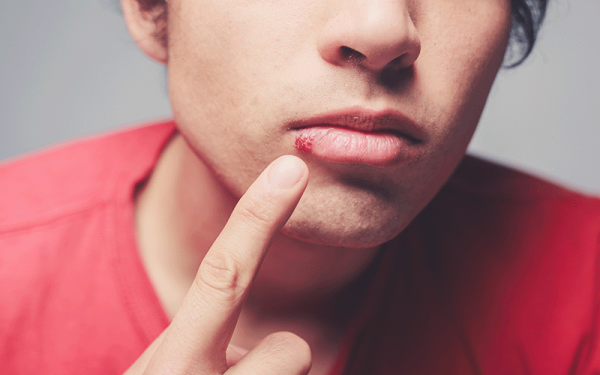Cold sores, also known as fever blisters, are an embarrassing and sometimes painful problem that is caused by herpes (HSV) virus.
Although there is a social stigma associated with cold sores, they are actually very common. Almost 90 percent of the population will experience at least one cold sore at some point during their lives. In this blog, we address questions you may have about them and cold sore stages.
“Most people already have the virus that causes cold sores but do not show any symptoms,” says Dr. Michael Dunningan of US Dermatology Partners Greenville. “Many are exposed during childhood and may never even know they have it.”
How do you know if you are developing a cold sore? The truth is, there are several cold sore stages. Below is what you need to know about the virus and how to treat an outbreak.
What Is a Cold Sore?
Cold sores are groups of blisters that typically appear on the lips and around the mouth, although they can show up anywhere on your body, including the nose, cheeks or eyes.
Sores can also develop inside the mouth, on the tongue or in the throat. Symptoms are often the most severe the first time you get a cold sore, which means your first outbreak is generally the worst. There are three common cold sore stages.
Stage #1: Pain or Tingling
Symptoms can begin as pain or tingling near your mouth and lips or can appear as a fever, swollen glands in your neck, or even a sore throat. These symptoms generally begin around one day before a cold sore develops. If you can catch an outbreak at this early stage, treatment can reduce the severity of blisters and shorten the outbreak.
Stage #2: Blisters
Soon — usually a day or two — after the pain and tingling arrive, fluid-filled blisters will appear on the skin and break open after a few days, oozing clear fluid.
“This is the stage when cold sores are most contagious,” says Dr. Dunnigan. “Picking at the sores can cause the virus to spread and can also lead to a bacterial infection on the skin, so it is important to keep your hands away from the blisters to let them heal.”
Stage #3: Scabs
As the blisters dry out, a scab or yellow-brown crust will build up. Eventually, this crust will fall off, leaving healed skin underneath. Cold sores typically last 7-10 days and are contagious until they scab over completely. This crusting and healing process could take up to two weeks.
How Do You Get Cold Sores?
Cold sores are caused by one of two types of herpes simplex virus: HSV type 1 (the most common) and HSV type 2 (the virus that typically causes genital herpes). Around two-thirds of the world’s population has cold sores or carries HSV-1 and, according to the Centers for Disease Control and Prevention (CDC), more than one out of every six people in the U.S. ages 14 to 49 years old has genital herpes.
Cold sores can develop up to 20 days after exposure to the virus and are highly contagious. Often, recurrences of cold sores will be in the same place as past outbreaks.
Typically, you catch HSV by coming in physical contact with someone who is infected — through kissing or sexual contact — but the virus can also be spread through inanimate objects. Sharing things with someone with active cold sores such as forks, cups or lipstick can also lead to infection.
Though the virus is most contagious when cold sore blisters are active, it can also be spread even when no cold sores are visibly present. Anyone who has been exposed to the virus is at risk for contracting cold sores, and those with weakened immune systems are especially vulnerable to contracting the virus.
Can You Get Cold Sores Again?
Some people have cold sores only once, though many have repeated outbreaks.
Once you have been exposed to the virus, outbreaks can be triggered by stress, illness, allergies, extreme weather, sunburn or even menstruation. During an outbreak, you can protect other people by not kissing or sharing food, utensils or hygiene items. Also, remember to wash your hands after touching affected areas.
There is no cure for cold sores, but there are treatments for the symptoms, including topical creams and ointments such as docosanol (Abreva), which is available over the counter, and prescription-strength Zovirax and Denavir, which can be prescribed by your doctor. Oral medication such as valacyclovir (Valtrex) and famciclovir (Famvir) can also be prescribed to treat cold sores.
Over-the-counter pain relievers such as Tylenol or Advil can also be used to treat the minor pain and discomfort associated with cold sores.
“There is no cure for herpes, but if you have recurring cold sores, prescription medication can help to reduce the frequency and severity of outbreaks,” says Dr. Dunnigan. “If sores don’t clear within two weeks or are accompanied by a fever — or if the virus spreads to your eyes — you should make an appointment with your doctor.”
If you are carrying the virus that causes cold sores, the best way to avoid an outbreak is to manage your stress by eating healthy foods, exercising regularly and getting plenty of sleep.
Looking to Visit a Dermatologist for Cold Sores?
To learn more about treatment options for cold sores and how you can better manage future outbreaks, contact U.S. Dermatology Partners today. We have multiple locations throughout the country, so fill out our simple online form to get in touch with us. One of our local team members will reach out to you shortly to answer your questions or schedule an appointment for you to visit us soon.
Find a location near me
or

